PVAnalytics QA Process: Wind Speed#
import pvanalytics
import numpy as np
import rdtools
from statistics import mode
import json
# pvanalytics.__version__
from pvanalytics.features.clearsky import reno #update to just do a pvanalytics import?
import pvlib
import matplotlib.pyplot as plt
import pandas as pd
from pvanalytics.quality import data_shifts as ds
from pvanalytics.quality import gaps
from pvanalytics.quality.outliers import zscore
from pvanalytics.features.daytime import power_or_irradiance
from pvanalytics.quality.time import shifts_ruptures
from pvanalytics.features import daytime
from pvanalytics.system import (is_tracking_envelope,
infer_orientation_fit_pvwatts)
from pvanalytics.features.clipping import geometric
from pvanalytics.features.clearsky import reno
import ruptures as rpt
import os
import matplotlib.pyplot as plt
import matplotlib
matplotlib.rcParams.update({'font.size': 12,
'figure.figsize': [4.5, 3],
'lines.markeredgewidth': 0,
'lines.markersize': 2
})
In the following example, a process for assessing the data quality of a wind speed data stream is shown, using PVAnalytics functions. These example pipelines illustrates how several PVAnalytics functions can be used in sequence to assess the quality of a wind speed data stream.
First, we download and import the wind speed data stream from a PV installation under the 2023 solar data prize data set. This data set is publicly available via the PVDAQ database in the DOE Open Energy Data Initiative (OEDI) (https://data.openei.org/submissions/4568), under system ID 2107. This data is timezone-localized.
with open('./data/2107_system_metadata.json', 'r') as f:
metadata = json.load(f)
tz = metadata['System']['timezone_code']
def load_csv(file_path):
df = pd.read_csv(
file_path,
index_col=0,
parse_dates=True,
)
return df
df_env = load_csv("./data/2107_environment_data.csv")
df_env = df_env.tz_localize(tz, ambiguous=True)
latitude = metadata['Site']['latitude']
longitude = metadata['Site']['longitude']
# Get wind speed column and turn it into a series
wind_time_series = df_env['wind_speed_o_149576']
wind_time_series.plot(title="Original Time Series")
plt.xlabel("Date")
plt.ylabel("Wind speed (m/s)")
plt.show()
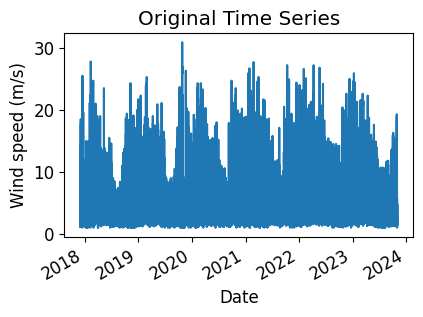
Run Basic Data Checks#
Now, let’s run basic data checks to identify stale and abnormal/outlier data in the time series. Basic data checks include the following steps:
Flatlined/stale data periods (pvanalytics.quality.gaps.stale_values_round()).
Outliers, which are defined as more than one 5 standard deviations away from the mean (pvanalytics.quality.outliers.zscore()).
# REMOVE STALE DATA
stale_data_mask = gaps.stale_values_round(wind_time_series,
window=3,
decimals=2, mark = "tail")
# FIND OUTLIERS (Z-SCORE FILTER)
zscore_outlier_mask = zscore(wind_time_series,
zmax=5,
nan_policy='omit')
# Get the percentage of data flagged for each issue, so it can later be logged
pct_stale = round((len(wind_time_series[
stale_data_mask].dropna())/len(wind_time_series.dropna())*100), 1)
pct_outlier = round((len(wind_time_series[
zscore_outlier_mask].dropna())/len(wind_time_series.dropna())*100), 1)
# Visualize all of the time series issues (stale, abnormal, outlier)
wind_time_series.plot()
labels = ["Wind Speed"]
if any(stale_data_mask):
wind_time_series.loc[stale_data_mask].plot(ls='',
marker='o',
color="green")
labels.append("Stale")
if any(zscore_outlier_mask):
wind_time_series.loc[zscore_outlier_mask].plot(ls='',
marker='o',
color="purple")
labels.append("Outlier")
plt.legend(labels=labels)
plt.title("Time Series Labeled for Basic Issues")
plt.xticks(rotation=20)
plt.xlabel("Date")
plt.ylabel(f"Wind Speed (m/s)")
plt.tight_layout()
plt.show()
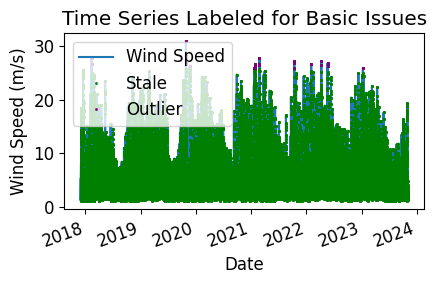
Now, let’s filter out any of the flagged data from the basic temperature checks (stale or abnormal data).
# Filter the time series, taking out all of the issues
issue_mask = ((~stale_data_mask) & (~zscore_outlier_mask))
wind_time_series = wind_time_series[issue_mask].copy()
Daily Completeness Check#
We filter the time series based on its daily completeness score. This filtering scheme requires at least 25% of data to be present for each day to be included.
# Get the time frequency of the time series
freq_minutes = mode(wind_time_series.index.to_series().diff().dt.seconds / 60)
data_freq = str(freq_minutes) + "min"
wind_time_series = wind_time_series.asfreq(data_freq)
# Visualize daily data completeness
# Data frequency chaged to 60T due to duplicated data for every hr
# data_completeness_score = gaps.completeness_score(wind_time_series.asfreq("60T"))
data_completeness_score = gaps.completeness_score(wind_time_series)
# Visualize data completeness score as a time series.
data_completeness_score.plot()
plt.xlabel("Date")
plt.ylabel("Daily Completeness Score (Fractional)")
plt.axhline(y=0.25, color='r', linestyle='-',
label='Daily Completeness Cutoff')
plt.legend()
plt.tight_layout()
plt.show()
# Trim the series based on daily completeness score
trim_series_mask = pvanalytics.quality.gaps.trim_incomplete(
wind_time_series,
minimum_completeness=.25,
freq=data_freq)
wind_time_series = wind_time_series[trim_series_mask]
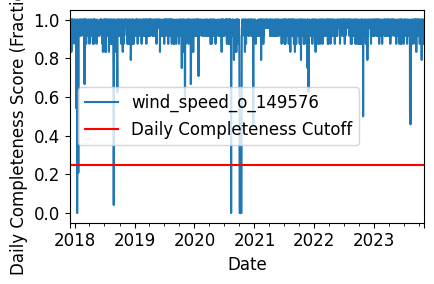
Data/Capacity Shifts#
Next, we check the time series for any abrupt data shifts. We take the longest continuous part of the time series that is free of data shifts. We use pvanalytics.quality.data_shifts.detect_data_shifts() to detect data shifts in the time series.
# Resample the time series to daily mean
wind_time_series_daily = wind_time_series.resample('D').mean()
data_shift_start_date, data_shift_end_date = \
ds.get_longest_shift_segment_dates(wind_time_series_daily)
data_shift_period_length = (data_shift_end_date -
data_shift_start_date).days
# Get the number of shift dates
data_shift_mask = ds.detect_data_shifts(wind_time_series_daily)
# Get the shift dates
shift_dates = list(wind_time_series_daily[data_shift_mask].index)
if len(shift_dates) > 0:
shift_found = True
else:
shift_found = False
# Visualize the time shifts for the daily time series
print("Shift Found: ", shift_found)
edges = ([wind_time_series_daily.index[0]] + shift_dates +
[wind_time_series_daily.index[-1]])
fig, ax = plt.subplots()
for (st, ed) in zip(edges[:-1], edges[1:]):
ax.plot(wind_time_series_daily.loc[st:ed])
plt.title("Daily Time Series Labeled for Data Shifts")
plt.xlabel("Date")
plt.ylabel(f"Wind Speed (m/s)")
plt.show()
Shift Found: False
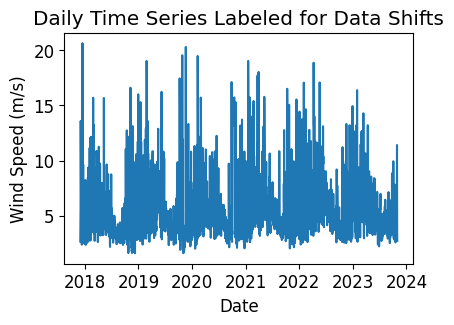
Final Filtered Wind Speed Series#
Finally, we filter the time series to only include the longest shift-free period. We then visualize the final time series post-QA filtering.
wind_time_series = wind_time_series[
(wind_time_series.index >=
data_shift_start_date.tz_convert(wind_time_series.index.tz)) &
(wind_time_series.index <=
data_shift_end_date.tz_convert(wind_time_series.index.tz))]
# Plot the final filtered time series.
wind_time_series.plot(title="Final Filtered Time Series")
plt.xlabel("Date")
plt.ylabel(f"Wind Speed (m/s)")
plt.show()
wind_time_series.to_pickle("./data/wind_speed_o_149576.pkl")
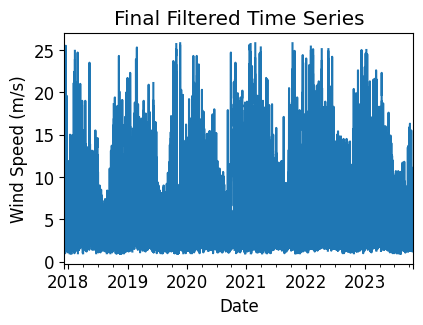
Generate a dictionary output for the QA assessment of this data stream, including the percent stale and erroneous data detected, and any shift dates.
qa_check_dict = {"pct_stale": pct_stale,
"pct_outlier": pct_outlier,
"data_shifts": shift_found,
"shift_dates": shift_dates}
print("QA Results:")
print(qa_check_dict)
QA Results:
{'pct_stale': 76.1, 'pct_outlier': 0.1, 'data_shifts': False, 'shift_dates': []}
